Research: Digital Technology Impact on Business Activity, Brainlabs
VerifiedAdded on 2020/11/12
|13
|4053
|119
Report
AI Summary
This report presents a comprehensive analysis of the impact of digital technology on business activity, using Brainlabs as a case study. The introduction provides an overview of the research, background, significance, research aim, objectives, and research questions. Chapter 2 reviews the literature, focusing on the influence of modern techniques, the relationship between digital technology and company growth, and the drawbacks of implementation. Chapter 3 details the research methodology, including the types of investigation, research design, philosophy, approaches, data sampling, data collection, and ethical considerations. The report explores the role of digital technology in enhancing business operations, communication, data management, and customer relationship management, highlighting its influence on company performance and growth. The research aims to identify the impact of digital technology on business activity, with specific objectives to analyze modern techniques, the relationship between digital technology and organizational growth, and the drawbacks of implementation. The report also includes a Gantt chart outlining the timeline for the research activities.

Research Proposal
Paraphrase This Document
Need a fresh take? Get an instant paraphrase of this document with our AI Paraphraser
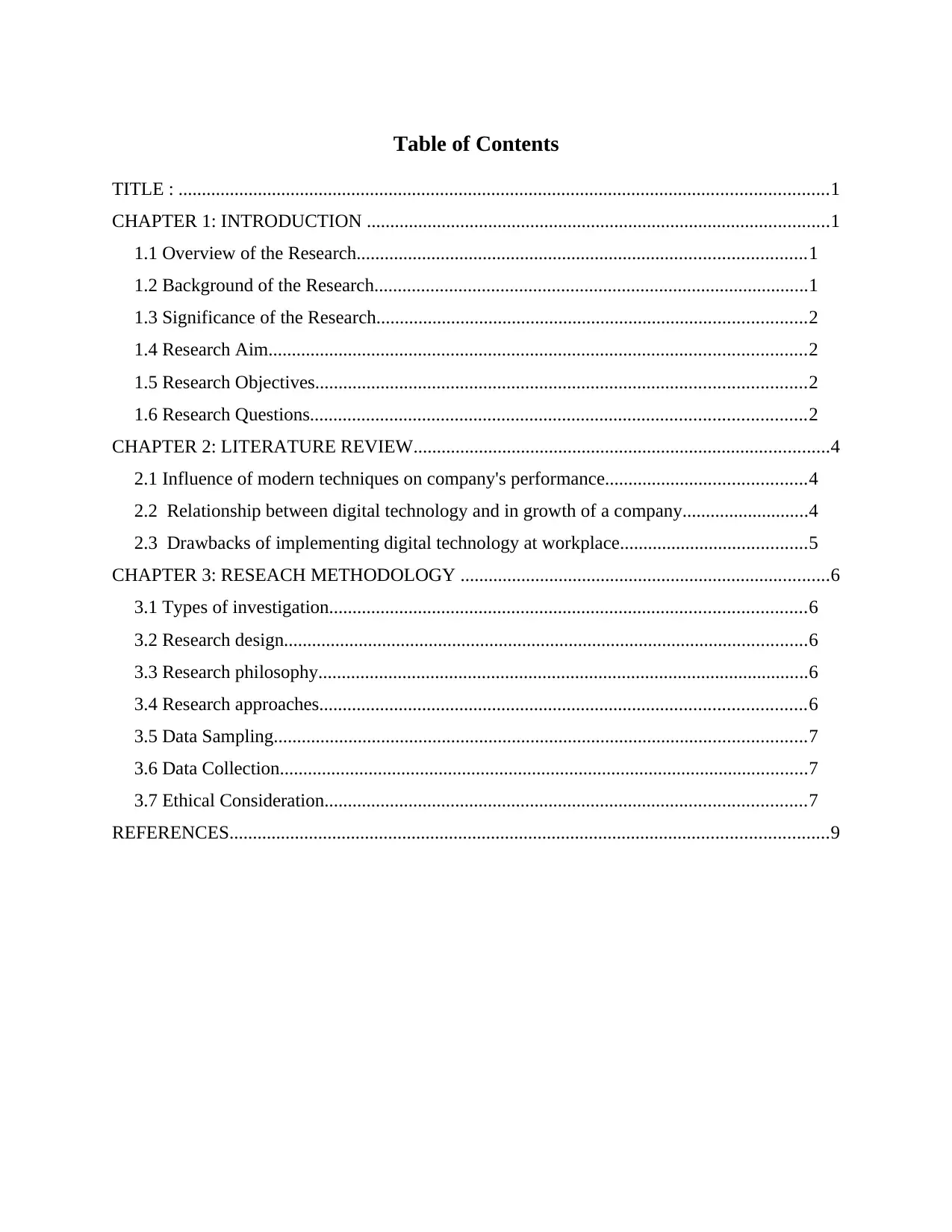
Table of Contents
TITLE : ...........................................................................................................................................1
CHAPTER 1: INTRODUCTION ...................................................................................................1
1.1 Overview of the Research................................................................................................1
1.2 Background of the Research.............................................................................................1
1.3 Significance of the Research............................................................................................2
1.4 Research Aim...................................................................................................................2
1.5 Research Objectives.........................................................................................................2
1.6 Research Questions..........................................................................................................2
CHAPTER 2: LITERATURE REVIEW.........................................................................................4
2.1 Influence of modern techniques on company's performance...........................................4
2.2 Relationship between digital technology and in growth of a company...........................4
2.3 Drawbacks of implementing digital technology at workplace........................................5
CHAPTER 3: RESEACH METHODOLOGY ...............................................................................6
3.1 Types of investigation......................................................................................................6
3.2 Research design................................................................................................................6
3.3 Research philosophy.........................................................................................................6
3.4 Research approaches........................................................................................................6
3.5 Data Sampling..................................................................................................................7
3.6 Data Collection.................................................................................................................7
3.7 Ethical Consideration.......................................................................................................7
REFERENCES................................................................................................................................9
TITLE : ...........................................................................................................................................1
CHAPTER 1: INTRODUCTION ...................................................................................................1
1.1 Overview of the Research................................................................................................1
1.2 Background of the Research.............................................................................................1
1.3 Significance of the Research............................................................................................2
1.4 Research Aim...................................................................................................................2
1.5 Research Objectives.........................................................................................................2
1.6 Research Questions..........................................................................................................2
CHAPTER 2: LITERATURE REVIEW.........................................................................................4
2.1 Influence of modern techniques on company's performance...........................................4
2.2 Relationship between digital technology and in growth of a company...........................4
2.3 Drawbacks of implementing digital technology at workplace........................................5
CHAPTER 3: RESEACH METHODOLOGY ...............................................................................6
3.1 Types of investigation......................................................................................................6
3.2 Research design................................................................................................................6
3.3 Research philosophy.........................................................................................................6
3.4 Research approaches........................................................................................................6
3.5 Data Sampling..................................................................................................................7
3.6 Data Collection.................................................................................................................7
3.7 Ethical Consideration.......................................................................................................7
REFERENCES................................................................................................................................9
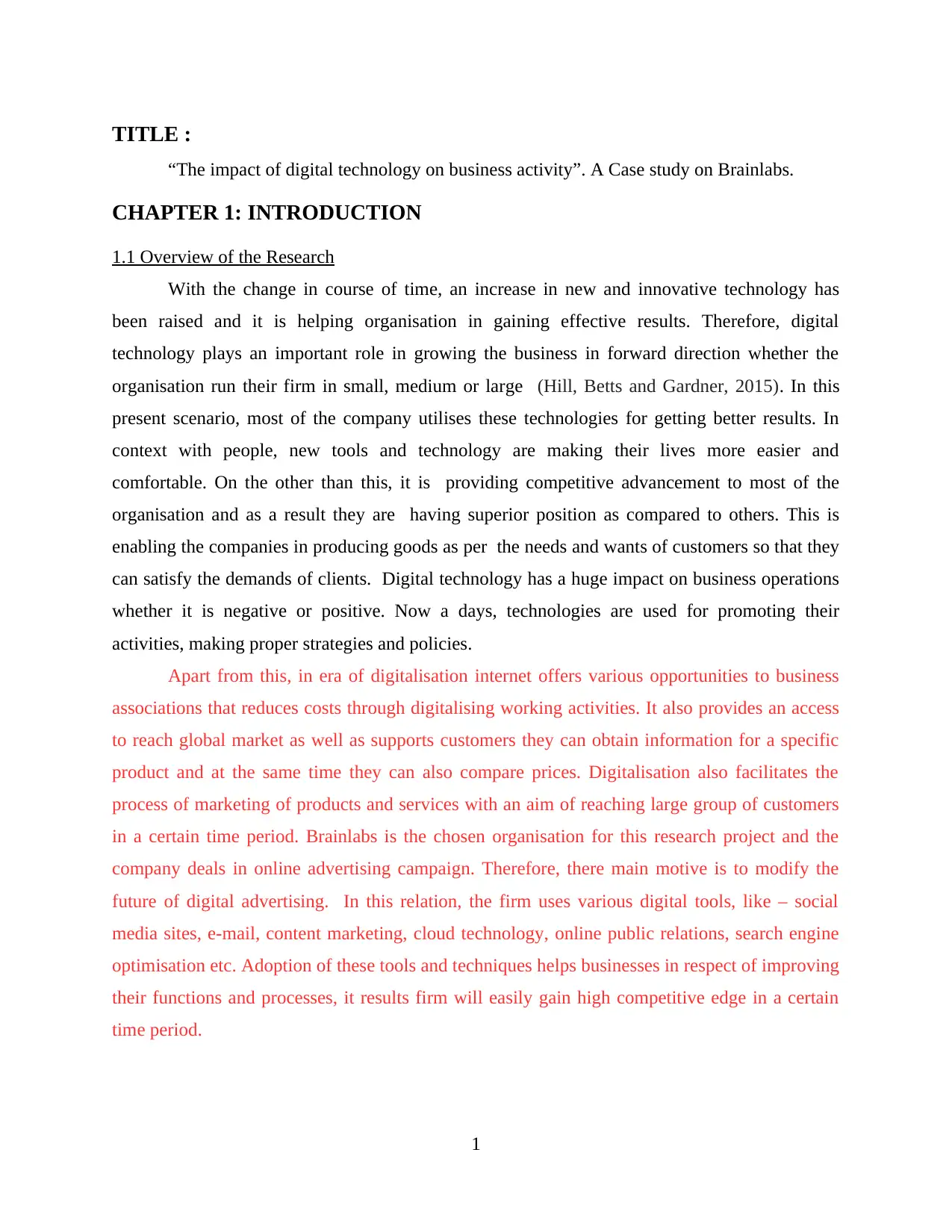
TITLE :
“The impact of digital technology on business activity”. A Case study on Brainlabs.
CHAPTER 1: INTRODUCTION
1.1 Overview of the Research
With the change in course of time, an increase in new and innovative technology has
been raised and it is helping organisation in gaining effective results. Therefore, digital
technology plays an important role in growing the business in forward direction whether the
organisation run their firm in small, medium or large (Hill, Betts and Gardner, 2015). In this
present scenario, most of the company utilises these technologies for getting better results. In
context with people, new tools and technology are making their lives more easier and
comfortable. On the other than this, it is providing competitive advancement to most of the
organisation and as a result they are having superior position as compared to others. This is
enabling the companies in producing goods as per the needs and wants of customers so that they
can satisfy the demands of clients. Digital technology has a huge impact on business operations
whether it is negative or positive. Now a days, technologies are used for promoting their
activities, making proper strategies and policies.
Apart from this, in era of digitalisation internet offers various opportunities to business
associations that reduces costs through digitalising working activities. It also provides an access
to reach global market as well as supports customers they can obtain information for a specific
product and at the same time they can also compare prices. Digitalisation also facilitates the
process of marketing of products and services with an aim of reaching large group of customers
in a certain time period. Brainlabs is the chosen organisation for this research project and the
company deals in online advertising campaign. Therefore, there main motive is to modify the
future of digital advertising. In this relation, the firm uses various digital tools, like – social
media sites, e-mail, content marketing, cloud technology, online public relations, search engine
optimisation etc. Adoption of these tools and techniques helps businesses in respect of improving
their functions and processes, it results firm will easily gain high competitive edge in a certain
time period.
1
“The impact of digital technology on business activity”. A Case study on Brainlabs.
CHAPTER 1: INTRODUCTION
1.1 Overview of the Research
With the change in course of time, an increase in new and innovative technology has
been raised and it is helping organisation in gaining effective results. Therefore, digital
technology plays an important role in growing the business in forward direction whether the
organisation run their firm in small, medium or large (Hill, Betts and Gardner, 2015). In this
present scenario, most of the company utilises these technologies for getting better results. In
context with people, new tools and technology are making their lives more easier and
comfortable. On the other than this, it is providing competitive advancement to most of the
organisation and as a result they are having superior position as compared to others. This is
enabling the companies in producing goods as per the needs and wants of customers so that they
can satisfy the demands of clients. Digital technology has a huge impact on business operations
whether it is negative or positive. Now a days, technologies are used for promoting their
activities, making proper strategies and policies.
Apart from this, in era of digitalisation internet offers various opportunities to business
associations that reduces costs through digitalising working activities. It also provides an access
to reach global market as well as supports customers they can obtain information for a specific
product and at the same time they can also compare prices. Digitalisation also facilitates the
process of marketing of products and services with an aim of reaching large group of customers
in a certain time period. Brainlabs is the chosen organisation for this research project and the
company deals in online advertising campaign. Therefore, there main motive is to modify the
future of digital advertising. In this relation, the firm uses various digital tools, like – social
media sites, e-mail, content marketing, cloud technology, online public relations, search engine
optimisation etc. Adoption of these tools and techniques helps businesses in respect of improving
their functions and processes, it results firm will easily gain high competitive edge in a certain
time period.
1
⊘ This is a preview!⊘
Do you want full access?
Subscribe today to unlock all pages.

Trusted by 1+ million students worldwide
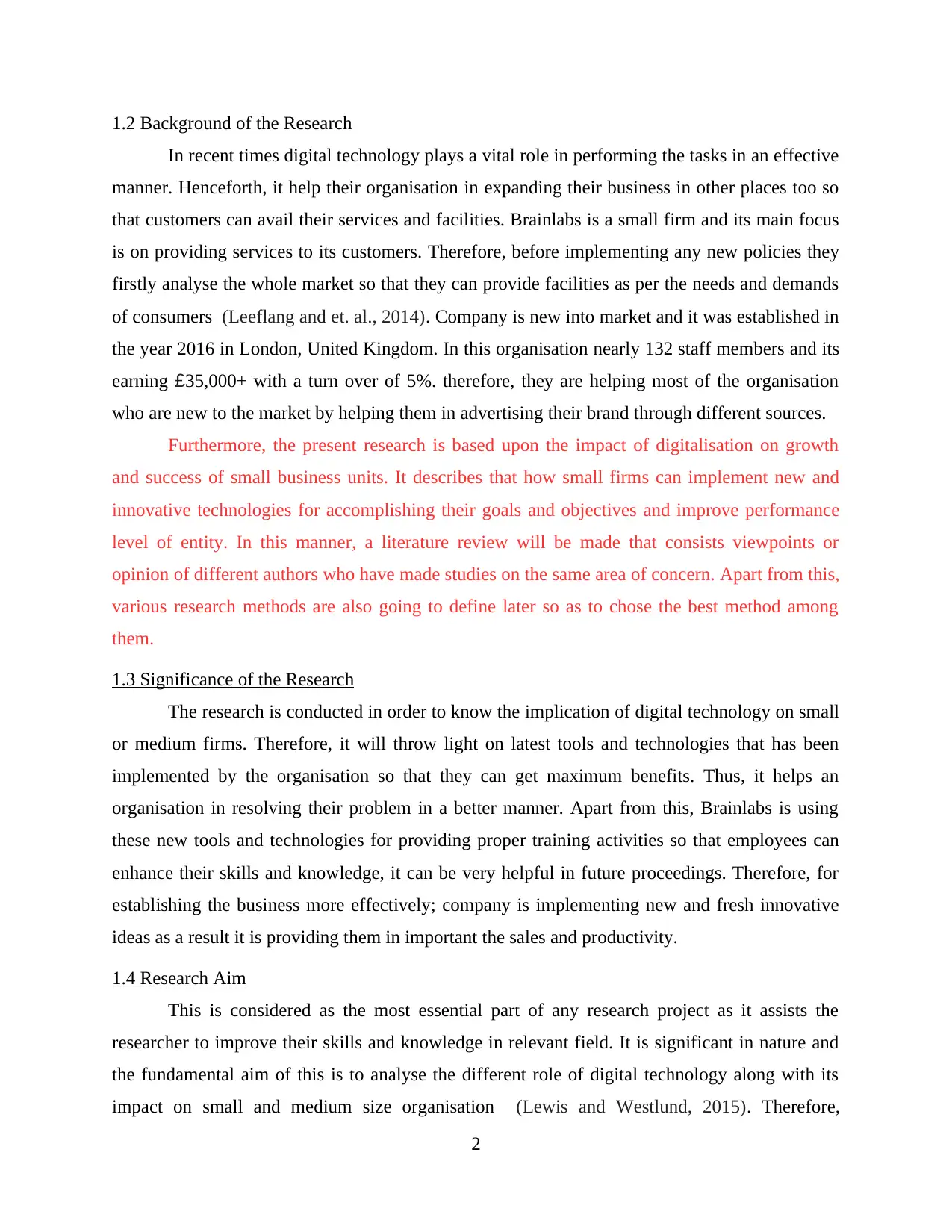
1.2 Background of the Research
In recent times digital technology plays a vital role in performing the tasks in an effective
manner. Henceforth, it help their organisation in expanding their business in other places too so
that customers can avail their services and facilities. Brainlabs is a small firm and its main focus
is on providing services to its customers. Therefore, before implementing any new policies they
firstly analyse the whole market so that they can provide facilities as per the needs and demands
of consumers (Leeflang and et. al., 2014). Company is new into market and it was established in
the year 2016 in London, United Kingdom. In this organisation nearly 132 staff members and its
earning £35,000+ with a turn over of 5%. therefore, they are helping most of the organisation
who are new to the market by helping them in advertising their brand through different sources.
Furthermore, the present research is based upon the impact of digitalisation on growth
and success of small business units. It describes that how small firms can implement new and
innovative technologies for accomplishing their goals and objectives and improve performance
level of entity. In this manner, a literature review will be made that consists viewpoints or
opinion of different authors who have made studies on the same area of concern. Apart from this,
various research methods are also going to define later so as to chose the best method among
them.
1.3 Significance of the Research
The research is conducted in order to know the implication of digital technology on small
or medium firms. Therefore, it will throw light on latest tools and technologies that has been
implemented by the organisation so that they can get maximum benefits. Thus, it helps an
organisation in resolving their problem in a better manner. Apart from this, Brainlabs is using
these new tools and technologies for providing proper training activities so that employees can
enhance their skills and knowledge, it can be very helpful in future proceedings. Therefore, for
establishing the business more effectively; company is implementing new and fresh innovative
ideas as a result it is providing them in important the sales and productivity.
1.4 Research Aim
This is considered as the most essential part of any research project as it assists the
researcher to improve their skills and knowledge in relevant field. It is significant in nature and
the fundamental aim of this is to analyse the different role of digital technology along with its
impact on small and medium size organisation (Lewis and Westlund, 2015). Therefore,
2
In recent times digital technology plays a vital role in performing the tasks in an effective
manner. Henceforth, it help their organisation in expanding their business in other places too so
that customers can avail their services and facilities. Brainlabs is a small firm and its main focus
is on providing services to its customers. Therefore, before implementing any new policies they
firstly analyse the whole market so that they can provide facilities as per the needs and demands
of consumers (Leeflang and et. al., 2014). Company is new into market and it was established in
the year 2016 in London, United Kingdom. In this organisation nearly 132 staff members and its
earning £35,000+ with a turn over of 5%. therefore, they are helping most of the organisation
who are new to the market by helping them in advertising their brand through different sources.
Furthermore, the present research is based upon the impact of digitalisation on growth
and success of small business units. It describes that how small firms can implement new and
innovative technologies for accomplishing their goals and objectives and improve performance
level of entity. In this manner, a literature review will be made that consists viewpoints or
opinion of different authors who have made studies on the same area of concern. Apart from this,
various research methods are also going to define later so as to chose the best method among
them.
1.3 Significance of the Research
The research is conducted in order to know the implication of digital technology on small
or medium firms. Therefore, it will throw light on latest tools and technologies that has been
implemented by the organisation so that they can get maximum benefits. Thus, it helps an
organisation in resolving their problem in a better manner. Apart from this, Brainlabs is using
these new tools and technologies for providing proper training activities so that employees can
enhance their skills and knowledge, it can be very helpful in future proceedings. Therefore, for
establishing the business more effectively; company is implementing new and fresh innovative
ideas as a result it is providing them in important the sales and productivity.
1.4 Research Aim
This is considered as the most essential part of any research project as it assists the
researcher to improve their skills and knowledge in relevant field. It is significant in nature and
the fundamental aim of this is to analyse the different role of digital technology along with its
impact on small and medium size organisation (Lewis and Westlund, 2015). Therefore,
2
Paraphrase This Document
Need a fresh take? Get an instant paraphrase of this document with our AI Paraphraser
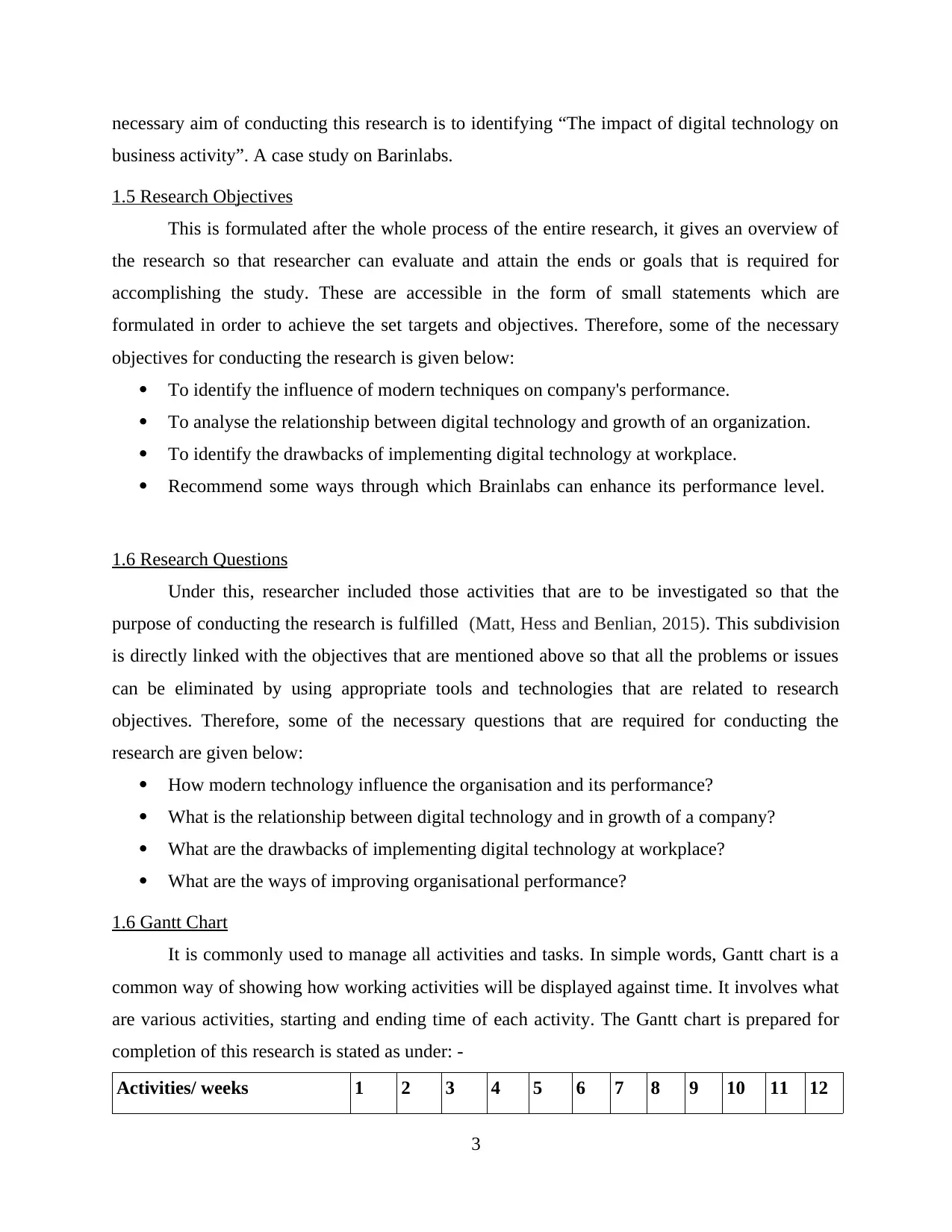
necessary aim of conducting this research is to identifying “The impact of digital technology on
business activity”. A case study on Barinlabs.
1.5 Research Objectives
This is formulated after the whole process of the entire research, it gives an overview of
the research so that researcher can evaluate and attain the ends or goals that is required for
accomplishing the study. These are accessible in the form of small statements which are
formulated in order to achieve the set targets and objectives. Therefore, some of the necessary
objectives for conducting the research is given below:
To identify the influence of modern techniques on company's performance.
To analyse the relationship between digital technology and growth of an organization.
To identify the drawbacks of implementing digital technology at workplace.
Recommend some ways through which Brainlabs can enhance its performance level.
1.6 Research Questions
Under this, researcher included those activities that are to be investigated so that the
purpose of conducting the research is fulfilled (Matt, Hess and Benlian, 2015). This subdivision
is directly linked with the objectives that are mentioned above so that all the problems or issues
can be eliminated by using appropriate tools and technologies that are related to research
objectives. Therefore, some of the necessary questions that are required for conducting the
research are given below:
How modern technology influence the organisation and its performance?
What is the relationship between digital technology and in growth of a company?
What are the drawbacks of implementing digital technology at workplace?
What are the ways of improving organisational performance?
1.6 Gantt Chart
It is commonly used to manage all activities and tasks. In simple words, Gantt chart is a
common way of showing how working activities will be displayed against time. It involves what
are various activities, starting and ending time of each activity. The Gantt chart is prepared for
completion of this research is stated as under: -
Activities/ weeks 1 2 3 4 5 6 7 8 9 10 11 12
3
business activity”. A case study on Barinlabs.
1.5 Research Objectives
This is formulated after the whole process of the entire research, it gives an overview of
the research so that researcher can evaluate and attain the ends or goals that is required for
accomplishing the study. These are accessible in the form of small statements which are
formulated in order to achieve the set targets and objectives. Therefore, some of the necessary
objectives for conducting the research is given below:
To identify the influence of modern techniques on company's performance.
To analyse the relationship between digital technology and growth of an organization.
To identify the drawbacks of implementing digital technology at workplace.
Recommend some ways through which Brainlabs can enhance its performance level.
1.6 Research Questions
Under this, researcher included those activities that are to be investigated so that the
purpose of conducting the research is fulfilled (Matt, Hess and Benlian, 2015). This subdivision
is directly linked with the objectives that are mentioned above so that all the problems or issues
can be eliminated by using appropriate tools and technologies that are related to research
objectives. Therefore, some of the necessary questions that are required for conducting the
research are given below:
How modern technology influence the organisation and its performance?
What is the relationship between digital technology and in growth of a company?
What are the drawbacks of implementing digital technology at workplace?
What are the ways of improving organisational performance?
1.6 Gantt Chart
It is commonly used to manage all activities and tasks. In simple words, Gantt chart is a
common way of showing how working activities will be displayed against time. It involves what
are various activities, starting and ending time of each activity. The Gantt chart is prepared for
completion of this research is stated as under: -
Activities/ weeks 1 2 3 4 5 6 7 8 9 10 11 12
3
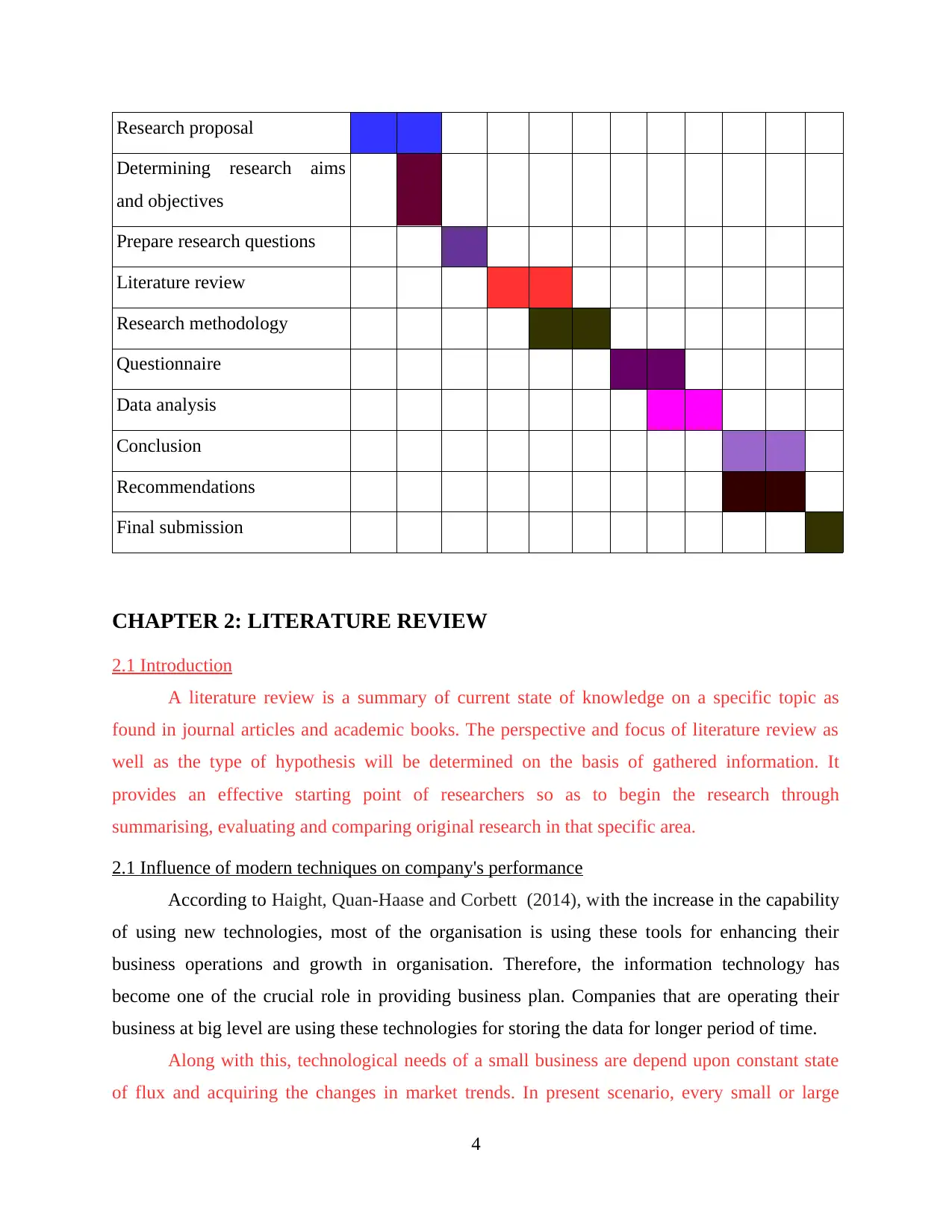
Research proposal
Determining research aims
and objectives
Prepare research questions
Literature review
Research methodology
Questionnaire
Data analysis
Conclusion
Recommendations
Final submission
CHAPTER 2: LITERATURE REVIEW
2.1 Introduction
A literature review is a summary of current state of knowledge on a specific topic as
found in journal articles and academic books. The perspective and focus of literature review as
well as the type of hypothesis will be determined on the basis of gathered information. It
provides an effective starting point of researchers so as to begin the research through
summarising, evaluating and comparing original research in that specific area.
2.1 Influence of modern techniques on company's performance
According to Haight, Quan-Haase and Corbett (2014), with the increase in the capability
of using new technologies, most of the organisation is using these tools for enhancing their
business operations and growth in organisation. Therefore, the information technology has
become one of the crucial role in providing business plan. Companies that are operating their
business at big level are using these technologies for storing the data for longer period of time.
Along with this, technological needs of a small business are depend upon constant state
of flux and acquiring the changes in market trends. In present scenario, every small or large
4
Determining research aims
and objectives
Prepare research questions
Literature review
Research methodology
Questionnaire
Data analysis
Conclusion
Recommendations
Final submission
CHAPTER 2: LITERATURE REVIEW
2.1 Introduction
A literature review is a summary of current state of knowledge on a specific topic as
found in journal articles and academic books. The perspective and focus of literature review as
well as the type of hypothesis will be determined on the basis of gathered information. It
provides an effective starting point of researchers so as to begin the research through
summarising, evaluating and comparing original research in that specific area.
2.1 Influence of modern techniques on company's performance
According to Haight, Quan-Haase and Corbett (2014), with the increase in the capability
of using new technologies, most of the organisation is using these tools for enhancing their
business operations and growth in organisation. Therefore, the information technology has
become one of the crucial role in providing business plan. Companies that are operating their
business at big level are using these technologies for storing the data for longer period of time.
Along with this, technological needs of a small business are depend upon constant state
of flux and acquiring the changes in market trends. In present scenario, every small or large
4
⊘ This is a preview!⊘
Do you want full access?
Subscribe today to unlock all pages.

Trusted by 1+ million students worldwide
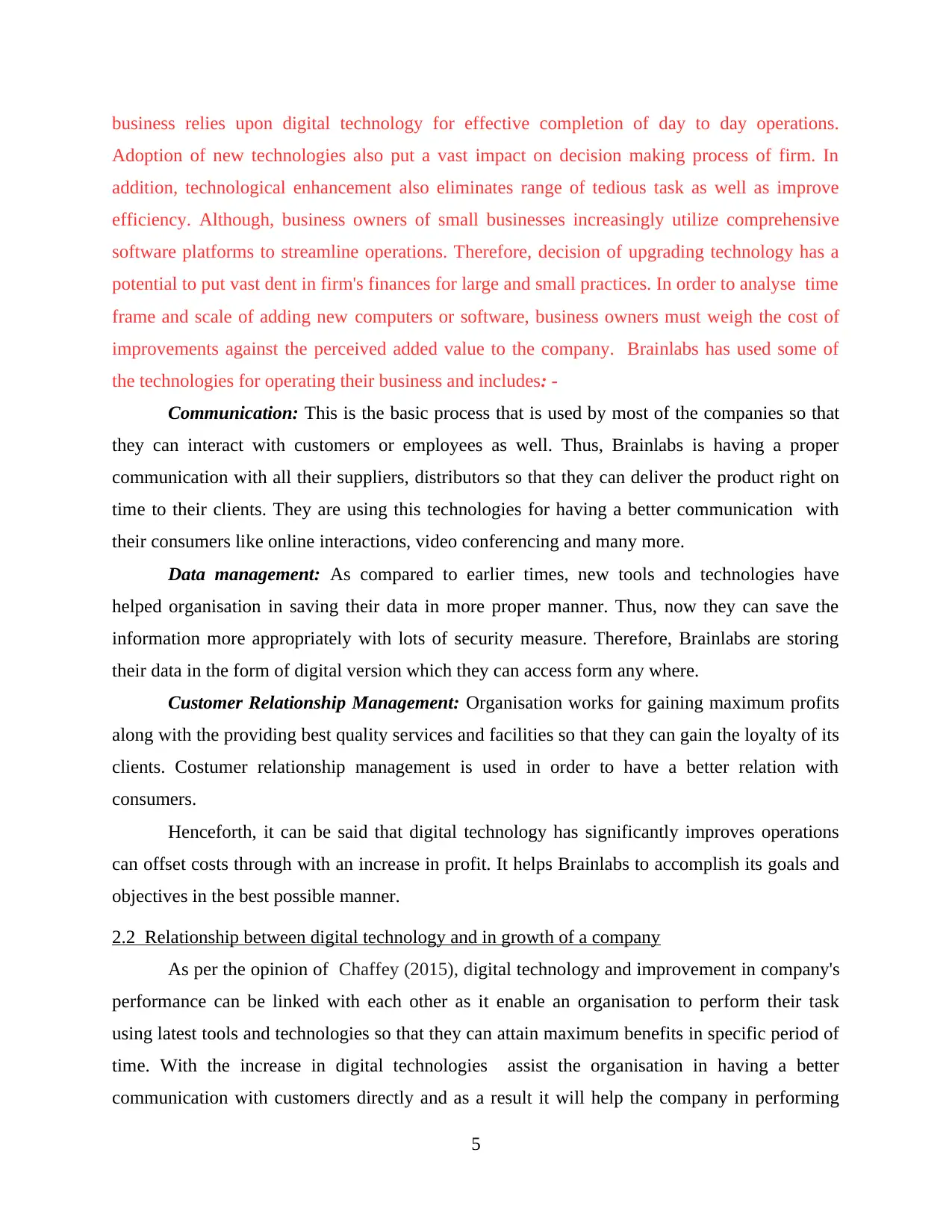
business relies upon digital technology for effective completion of day to day operations.
Adoption of new technologies also put a vast impact on decision making process of firm. In
addition, technological enhancement also eliminates range of tedious task as well as improve
efficiency. Although, business owners of small businesses increasingly utilize comprehensive
software platforms to streamline operations. Therefore, decision of upgrading technology has a
potential to put vast dent in firm's finances for large and small practices. In order to analyse time
frame and scale of adding new computers or software, business owners must weigh the cost of
improvements against the perceived added value to the company. Brainlabs has used some of
the technologies for operating their business and includes: -
Communication: This is the basic process that is used by most of the companies so that
they can interact with customers or employees as well. Thus, Brainlabs is having a proper
communication with all their suppliers, distributors so that they can deliver the product right on
time to their clients. They are using this technologies for having a better communication with
their consumers like online interactions, video conferencing and many more.
Data management: As compared to earlier times, new tools and technologies have
helped organisation in saving their data in more proper manner. Thus, now they can save the
information more appropriately with lots of security measure. Therefore, Brainlabs are storing
their data in the form of digital version which they can access form any where.
Customer Relationship Management: Organisation works for gaining maximum profits
along with the providing best quality services and facilities so that they can gain the loyalty of its
clients. Costumer relationship management is used in order to have a better relation with
consumers.
Henceforth, it can be said that digital technology has significantly improves operations
can offset costs through with an increase in profit. It helps Brainlabs to accomplish its goals and
objectives in the best possible manner.
2.2 Relationship between digital technology and in growth of a company
As per the opinion of Chaffey (2015), digital technology and improvement in company's
performance can be linked with each other as it enable an organisation to perform their task
using latest tools and technologies so that they can attain maximum benefits in specific period of
time. With the increase in digital technologies assist the organisation in having a better
communication with customers directly and as a result it will help the company in performing
5
Adoption of new technologies also put a vast impact on decision making process of firm. In
addition, technological enhancement also eliminates range of tedious task as well as improve
efficiency. Although, business owners of small businesses increasingly utilize comprehensive
software platforms to streamline operations. Therefore, decision of upgrading technology has a
potential to put vast dent in firm's finances for large and small practices. In order to analyse time
frame and scale of adding new computers or software, business owners must weigh the cost of
improvements against the perceived added value to the company. Brainlabs has used some of
the technologies for operating their business and includes: -
Communication: This is the basic process that is used by most of the companies so that
they can interact with customers or employees as well. Thus, Brainlabs is having a proper
communication with all their suppliers, distributors so that they can deliver the product right on
time to their clients. They are using this technologies for having a better communication with
their consumers like online interactions, video conferencing and many more.
Data management: As compared to earlier times, new tools and technologies have
helped organisation in saving their data in more proper manner. Thus, now they can save the
information more appropriately with lots of security measure. Therefore, Brainlabs are storing
their data in the form of digital version which they can access form any where.
Customer Relationship Management: Organisation works for gaining maximum profits
along with the providing best quality services and facilities so that they can gain the loyalty of its
clients. Costumer relationship management is used in order to have a better relation with
consumers.
Henceforth, it can be said that digital technology has significantly improves operations
can offset costs through with an increase in profit. It helps Brainlabs to accomplish its goals and
objectives in the best possible manner.
2.2 Relationship between digital technology and in growth of a company
As per the opinion of Chaffey (2015), digital technology and improvement in company's
performance can be linked with each other as it enable an organisation to perform their task
using latest tools and technologies so that they can attain maximum benefits in specific period of
time. With the increase in digital technologies assist the organisation in having a better
communication with customers directly and as a result it will help the company in performing
5
Paraphrase This Document
Need a fresh take? Get an instant paraphrase of this document with our AI Paraphraser
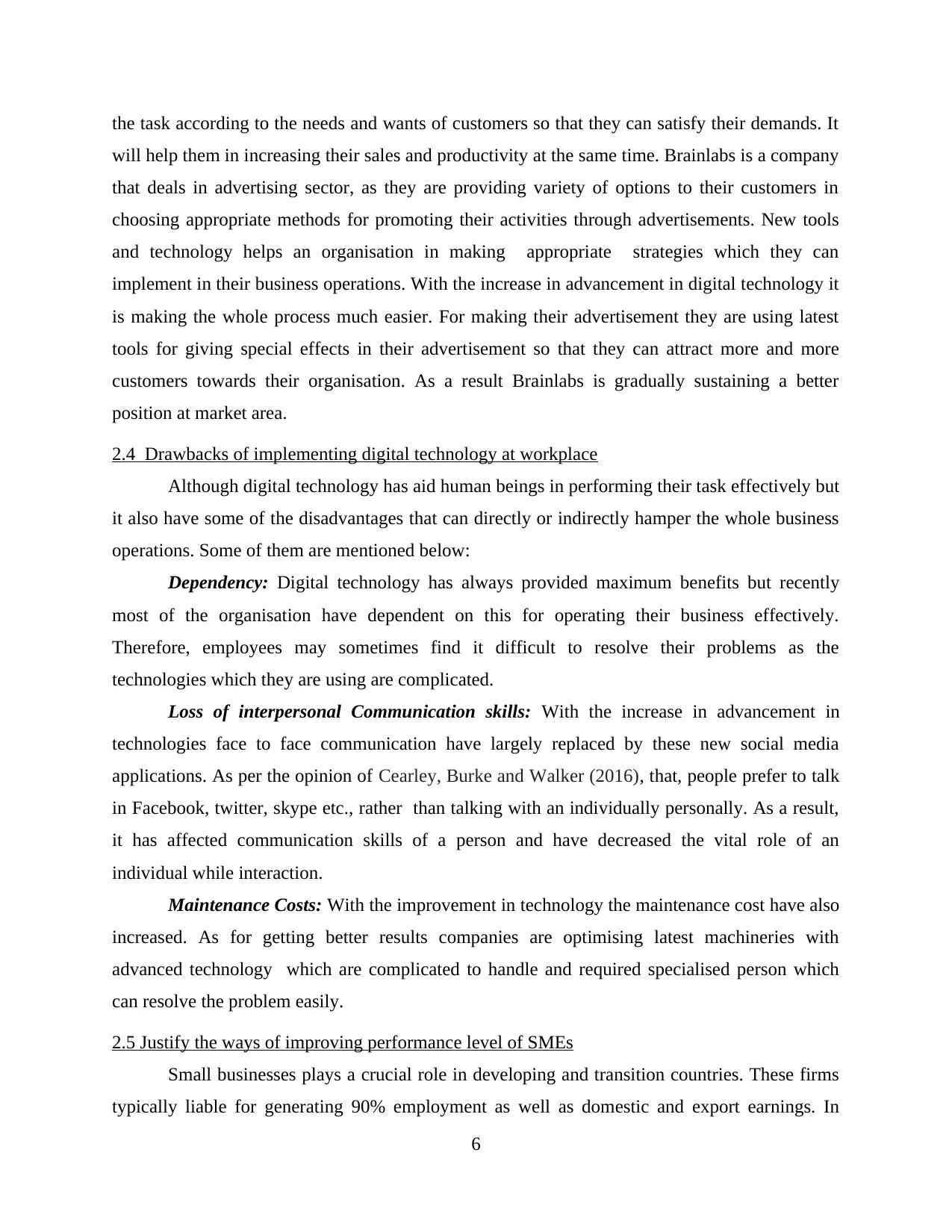
the task according to the needs and wants of customers so that they can satisfy their demands. It
will help them in increasing their sales and productivity at the same time. Brainlabs is a company
that deals in advertising sector, as they are providing variety of options to their customers in
choosing appropriate methods for promoting their activities through advertisements. New tools
and technology helps an organisation in making appropriate strategies which they can
implement in their business operations. With the increase in advancement in digital technology it
is making the whole process much easier. For making their advertisement they are using latest
tools for giving special effects in their advertisement so that they can attract more and more
customers towards their organisation. As a result Brainlabs is gradually sustaining a better
position at market area.
2.4 Drawbacks of implementing digital technology at workplace
Although digital technology has aid human beings in performing their task effectively but
it also have some of the disadvantages that can directly or indirectly hamper the whole business
operations. Some of them are mentioned below:
Dependency: Digital technology has always provided maximum benefits but recently
most of the organisation have dependent on this for operating their business effectively.
Therefore, employees may sometimes find it difficult to resolve their problems as the
technologies which they are using are complicated.
Loss of interpersonal Communication skills: With the increase in advancement in
technologies face to face communication have largely replaced by these new social media
applications. As per the opinion of Cearley, Burke and Walker (2016), that, people prefer to talk
in Facebook, twitter, skype etc., rather than talking with an individually personally. As a result,
it has affected communication skills of a person and have decreased the vital role of an
individual while interaction.
Maintenance Costs: With the improvement in technology the maintenance cost have also
increased. As for getting better results companies are optimising latest machineries with
advanced technology which are complicated to handle and required specialised person which
can resolve the problem easily.
2.5 Justify the ways of improving performance level of SMEs
Small businesses plays a crucial role in developing and transition countries. These firms
typically liable for generating 90% employment as well as domestic and export earnings. In
6
will help them in increasing their sales and productivity at the same time. Brainlabs is a company
that deals in advertising sector, as they are providing variety of options to their customers in
choosing appropriate methods for promoting their activities through advertisements. New tools
and technology helps an organisation in making appropriate strategies which they can
implement in their business operations. With the increase in advancement in digital technology it
is making the whole process much easier. For making their advertisement they are using latest
tools for giving special effects in their advertisement so that they can attract more and more
customers towards their organisation. As a result Brainlabs is gradually sustaining a better
position at market area.
2.4 Drawbacks of implementing digital technology at workplace
Although digital technology has aid human beings in performing their task effectively but
it also have some of the disadvantages that can directly or indirectly hamper the whole business
operations. Some of them are mentioned below:
Dependency: Digital technology has always provided maximum benefits but recently
most of the organisation have dependent on this for operating their business effectively.
Therefore, employees may sometimes find it difficult to resolve their problems as the
technologies which they are using are complicated.
Loss of interpersonal Communication skills: With the increase in advancement in
technologies face to face communication have largely replaced by these new social media
applications. As per the opinion of Cearley, Burke and Walker (2016), that, people prefer to talk
in Facebook, twitter, skype etc., rather than talking with an individually personally. As a result,
it has affected communication skills of a person and have decreased the vital role of an
individual while interaction.
Maintenance Costs: With the improvement in technology the maintenance cost have also
increased. As for getting better results companies are optimising latest machineries with
advanced technology which are complicated to handle and required specialised person which
can resolve the problem easily.
2.5 Justify the ways of improving performance level of SMEs
Small businesses plays a crucial role in developing and transition countries. These firms
typically liable for generating 90% employment as well as domestic and export earnings. In
6
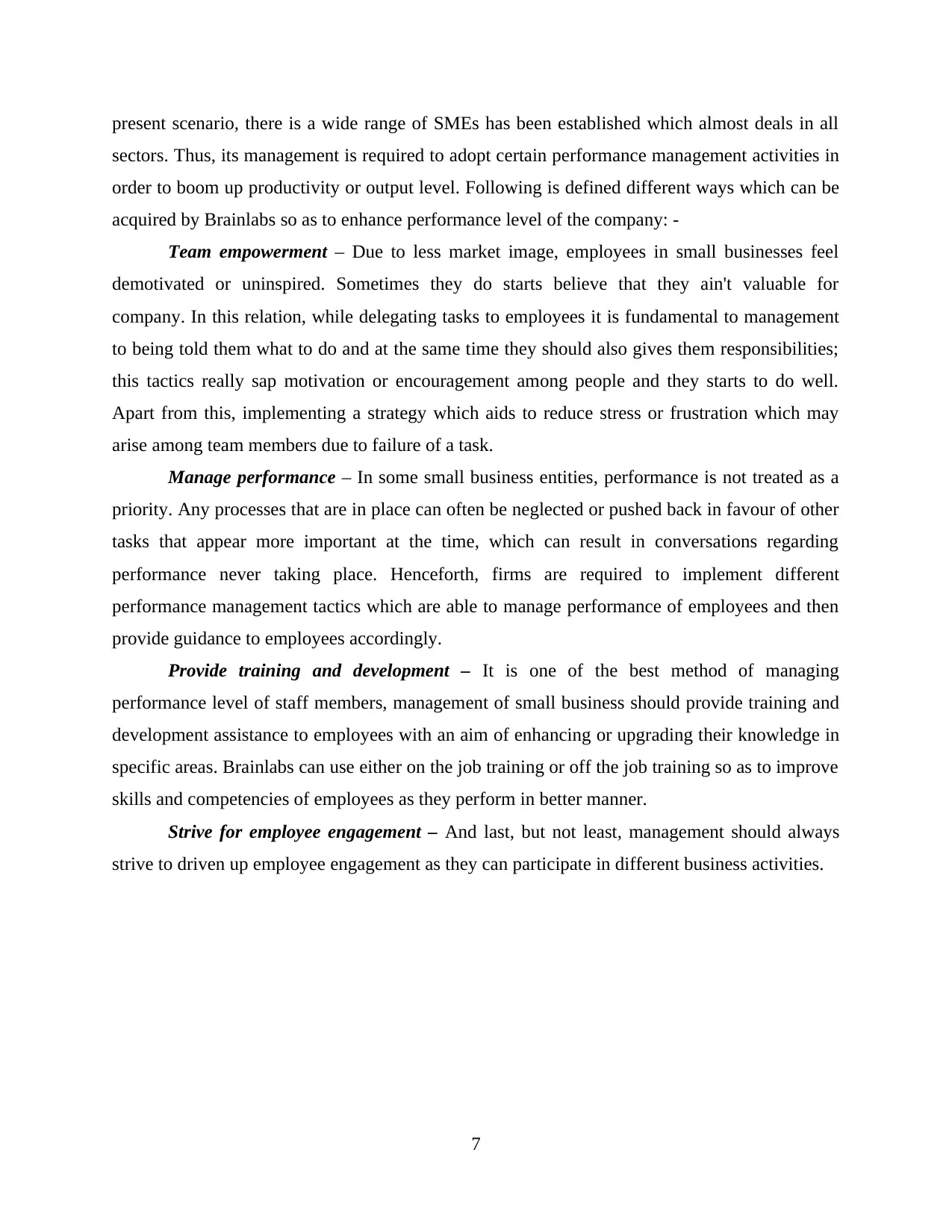
present scenario, there is a wide range of SMEs has been established which almost deals in all
sectors. Thus, its management is required to adopt certain performance management activities in
order to boom up productivity or output level. Following is defined different ways which can be
acquired by Brainlabs so as to enhance performance level of the company: -
Team empowerment – Due to less market image, employees in small businesses feel
demotivated or uninspired. Sometimes they do starts believe that they ain't valuable for
company. In this relation, while delegating tasks to employees it is fundamental to management
to being told them what to do and at the same time they should also gives them responsibilities;
this tactics really sap motivation or encouragement among people and they starts to do well.
Apart from this, implementing a strategy which aids to reduce stress or frustration which may
arise among team members due to failure of a task.
Manage performance – In some small business entities, performance is not treated as a
priority. Any processes that are in place can often be neglected or pushed back in favour of other
tasks that appear more important at the time, which can result in conversations regarding
performance never taking place. Henceforth, firms are required to implement different
performance management tactics which are able to manage performance of employees and then
provide guidance to employees accordingly.
Provide training and development – It is one of the best method of managing
performance level of staff members, management of small business should provide training and
development assistance to employees with an aim of enhancing or upgrading their knowledge in
specific areas. Brainlabs can use either on the job training or off the job training so as to improve
skills and competencies of employees as they perform in better manner.
Strive for employee engagement – And last, but not least, management should always
strive to driven up employee engagement as they can participate in different business activities.
7
sectors. Thus, its management is required to adopt certain performance management activities in
order to boom up productivity or output level. Following is defined different ways which can be
acquired by Brainlabs so as to enhance performance level of the company: -
Team empowerment – Due to less market image, employees in small businesses feel
demotivated or uninspired. Sometimes they do starts believe that they ain't valuable for
company. In this relation, while delegating tasks to employees it is fundamental to management
to being told them what to do and at the same time they should also gives them responsibilities;
this tactics really sap motivation or encouragement among people and they starts to do well.
Apart from this, implementing a strategy which aids to reduce stress or frustration which may
arise among team members due to failure of a task.
Manage performance – In some small business entities, performance is not treated as a
priority. Any processes that are in place can often be neglected or pushed back in favour of other
tasks that appear more important at the time, which can result in conversations regarding
performance never taking place. Henceforth, firms are required to implement different
performance management tactics which are able to manage performance of employees and then
provide guidance to employees accordingly.
Provide training and development – It is one of the best method of managing
performance level of staff members, management of small business should provide training and
development assistance to employees with an aim of enhancing or upgrading their knowledge in
specific areas. Brainlabs can use either on the job training or off the job training so as to improve
skills and competencies of employees as they perform in better manner.
Strive for employee engagement – And last, but not least, management should always
strive to driven up employee engagement as they can participate in different business activities.
7
⊘ This is a preview!⊘
Do you want full access?
Subscribe today to unlock all pages.

Trusted by 1+ million students worldwide
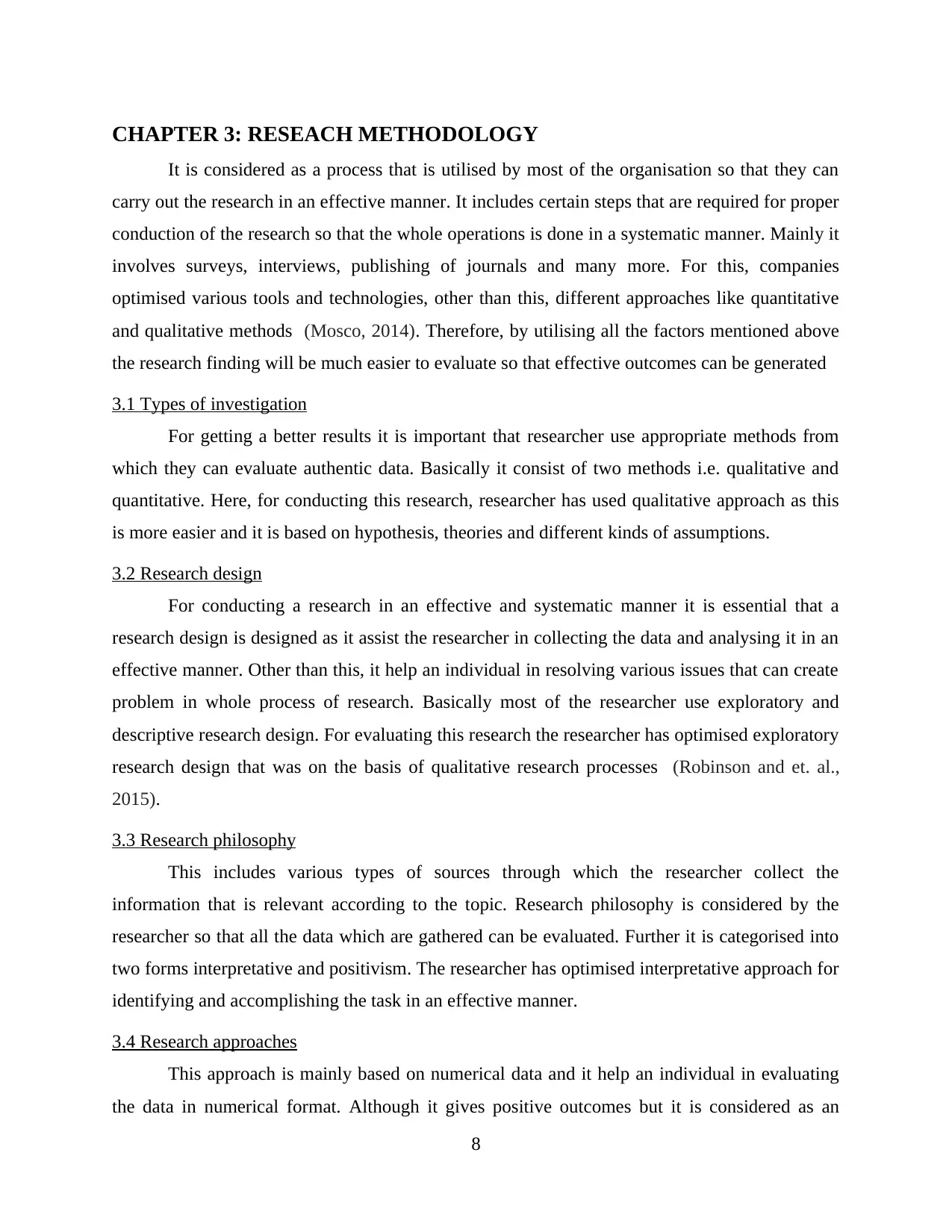
CHAPTER 3: RESEACH METHODOLOGY
It is considered as a process that is utilised by most of the organisation so that they can
carry out the research in an effective manner. It includes certain steps that are required for proper
conduction of the research so that the whole operations is done in a systematic manner. Mainly it
involves surveys, interviews, publishing of journals and many more. For this, companies
optimised various tools and technologies, other than this, different approaches like quantitative
and qualitative methods (Mosco, 2014). Therefore, by utilising all the factors mentioned above
the research finding will be much easier to evaluate so that effective outcomes can be generated
3.1 Types of investigation
For getting a better results it is important that researcher use appropriate methods from
which they can evaluate authentic data. Basically it consist of two methods i.e. qualitative and
quantitative. Here, for conducting this research, researcher has used qualitative approach as this
is more easier and it is based on hypothesis, theories and different kinds of assumptions.
3.2 Research design
For conducting a research in an effective and systematic manner it is essential that a
research design is designed as it assist the researcher in collecting the data and analysing it in an
effective manner. Other than this, it help an individual in resolving various issues that can create
problem in whole process of research. Basically most of the researcher use exploratory and
descriptive research design. For evaluating this research the researcher has optimised exploratory
research design that was on the basis of qualitative research processes (Robinson and et. al.,
2015).
3.3 Research philosophy
This includes various types of sources through which the researcher collect the
information that is relevant according to the topic. Research philosophy is considered by the
researcher so that all the data which are gathered can be evaluated. Further it is categorised into
two forms interpretative and positivism. The researcher has optimised interpretative approach for
identifying and accomplishing the task in an effective manner.
3.4 Research approaches
This approach is mainly based on numerical data and it help an individual in evaluating
the data in numerical format. Although it gives positive outcomes but it is considered as an
8
It is considered as a process that is utilised by most of the organisation so that they can
carry out the research in an effective manner. It includes certain steps that are required for proper
conduction of the research so that the whole operations is done in a systematic manner. Mainly it
involves surveys, interviews, publishing of journals and many more. For this, companies
optimised various tools and technologies, other than this, different approaches like quantitative
and qualitative methods (Mosco, 2014). Therefore, by utilising all the factors mentioned above
the research finding will be much easier to evaluate so that effective outcomes can be generated
3.1 Types of investigation
For getting a better results it is important that researcher use appropriate methods from
which they can evaluate authentic data. Basically it consist of two methods i.e. qualitative and
quantitative. Here, for conducting this research, researcher has used qualitative approach as this
is more easier and it is based on hypothesis, theories and different kinds of assumptions.
3.2 Research design
For conducting a research in an effective and systematic manner it is essential that a
research design is designed as it assist the researcher in collecting the data and analysing it in an
effective manner. Other than this, it help an individual in resolving various issues that can create
problem in whole process of research. Basically most of the researcher use exploratory and
descriptive research design. For evaluating this research the researcher has optimised exploratory
research design that was on the basis of qualitative research processes (Robinson and et. al.,
2015).
3.3 Research philosophy
This includes various types of sources through which the researcher collect the
information that is relevant according to the topic. Research philosophy is considered by the
researcher so that all the data which are gathered can be evaluated. Further it is categorised into
two forms interpretative and positivism. The researcher has optimised interpretative approach for
identifying and accomplishing the task in an effective manner.
3.4 Research approaches
This approach is mainly based on numerical data and it help an individual in evaluating
the data in numerical format. Although it gives positive outcomes but it is considered as an
8
Paraphrase This Document
Need a fresh take? Get an instant paraphrase of this document with our AI Paraphraser
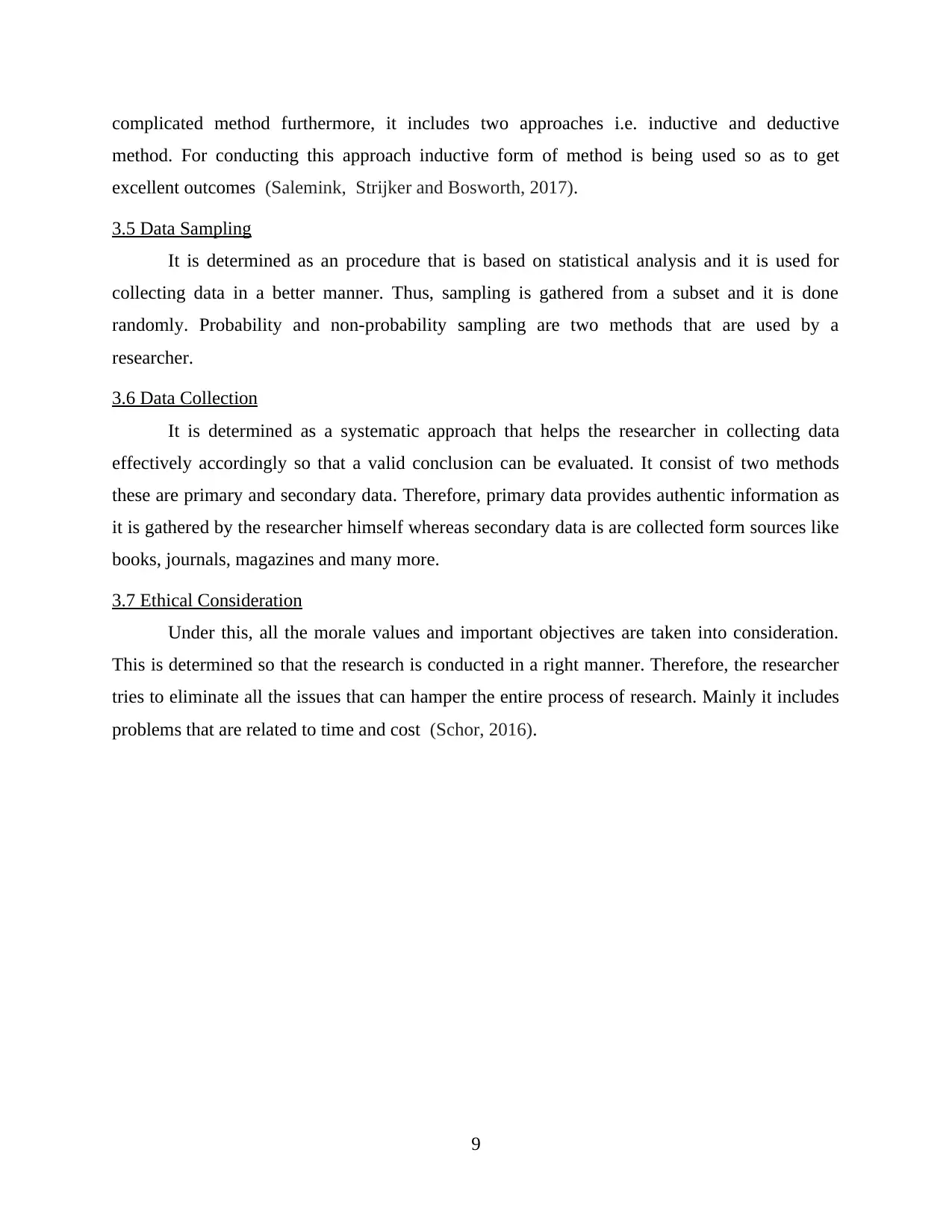
complicated method furthermore, it includes two approaches i.e. inductive and deductive
method. For conducting this approach inductive form of method is being used so as to get
excellent outcomes (Salemink, Strijker and Bosworth, 2017).
3.5 Data Sampling
It is determined as an procedure that is based on statistical analysis and it is used for
collecting data in a better manner. Thus, sampling is gathered from a subset and it is done
randomly. Probability and non-probability sampling are two methods that are used by a
researcher.
3.6 Data Collection
It is determined as a systematic approach that helps the researcher in collecting data
effectively accordingly so that a valid conclusion can be evaluated. It consist of two methods
these are primary and secondary data. Therefore, primary data provides authentic information as
it is gathered by the researcher himself whereas secondary data is are collected form sources like
books, journals, magazines and many more.
3.7 Ethical Consideration
Under this, all the morale values and important objectives are taken into consideration.
This is determined so that the research is conducted in a right manner. Therefore, the researcher
tries to eliminate all the issues that can hamper the entire process of research. Mainly it includes
problems that are related to time and cost (Schor, 2016).
9
method. For conducting this approach inductive form of method is being used so as to get
excellent outcomes (Salemink, Strijker and Bosworth, 2017).
3.5 Data Sampling
It is determined as an procedure that is based on statistical analysis and it is used for
collecting data in a better manner. Thus, sampling is gathered from a subset and it is done
randomly. Probability and non-probability sampling are two methods that are used by a
researcher.
3.6 Data Collection
It is determined as a systematic approach that helps the researcher in collecting data
effectively accordingly so that a valid conclusion can be evaluated. It consist of two methods
these are primary and secondary data. Therefore, primary data provides authentic information as
it is gathered by the researcher himself whereas secondary data is are collected form sources like
books, journals, magazines and many more.
3.7 Ethical Consideration
Under this, all the morale values and important objectives are taken into consideration.
This is determined so that the research is conducted in a right manner. Therefore, the researcher
tries to eliminate all the issues that can hamper the entire process of research. Mainly it includes
problems that are related to time and cost (Schor, 2016).
9
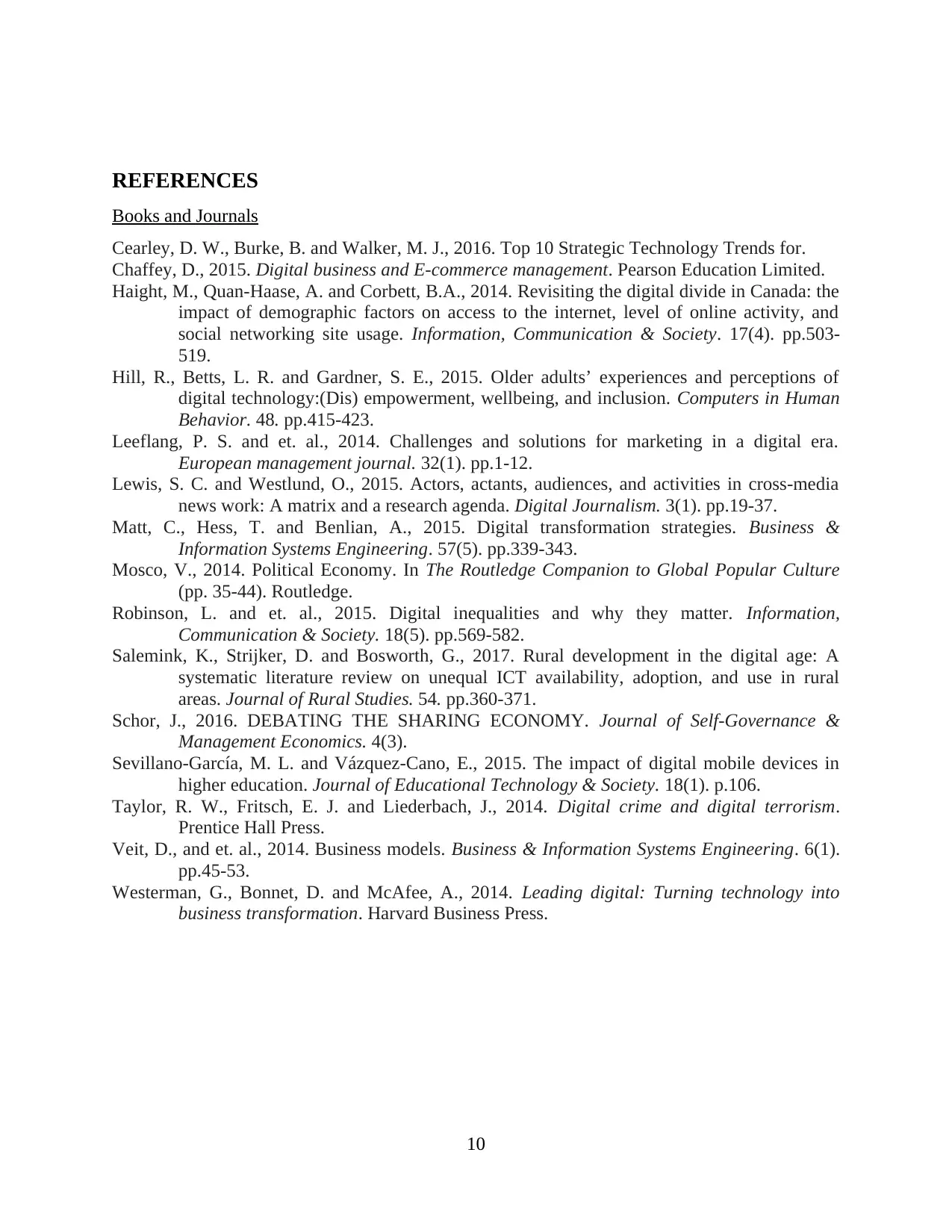
REFERENCES
Books and Journals
Cearley, D. W., Burke, B. and Walker, M. J., 2016. Top 10 Strategic Technology Trends for.
Chaffey, D., 2015. Digital business and E-commerce management. Pearson Education Limited.
Haight, M., Quan-Haase, A. and Corbett, B.A., 2014. Revisiting the digital divide in Canada: the
impact of demographic factors on access to the internet, level of online activity, and
social networking site usage. Information, Communication & Society. 17(4). pp.503-
519.
Hill, R., Betts, L. R. and Gardner, S. E., 2015. Older adults’ experiences and perceptions of
digital technology:(Dis) empowerment, wellbeing, and inclusion. Computers in Human
Behavior. 48. pp.415-423.
Leeflang, P. S. and et. al., 2014. Challenges and solutions for marketing in a digital era.
European management journal. 32(1). pp.1-12.
Lewis, S. C. and Westlund, O., 2015. Actors, actants, audiences, and activities in cross-media
news work: A matrix and a research agenda. Digital Journalism. 3(1). pp.19-37.
Matt, C., Hess, T. and Benlian, A., 2015. Digital transformation strategies. Business &
Information Systems Engineering. 57(5). pp.339-343.
Mosco, V., 2014. Political Economy. In The Routledge Companion to Global Popular Culture
(pp. 35-44). Routledge.
Robinson, L. and et. al., 2015. Digital inequalities and why they matter. Information,
Communication & Society. 18(5). pp.569-582.
Salemink, K., Strijker, D. and Bosworth, G., 2017. Rural development in the digital age: A
systematic literature review on unequal ICT availability, adoption, and use in rural
areas. Journal of Rural Studies. 54. pp.360-371.
Schor, J., 2016. DEBATING THE SHARING ECONOMY. Journal of Self-Governance &
Management Economics. 4(3).
Sevillano-García, M. L. and Vázquez-Cano, E., 2015. The impact of digital mobile devices in
higher education. Journal of Educational Technology & Society. 18(1). p.106.
Taylor, R. W., Fritsch, E. J. and Liederbach, J., 2014. Digital crime and digital terrorism.
Prentice Hall Press.
Veit, D., and et. al., 2014. Business models. Business & Information Systems Engineering. 6(1).
pp.45-53.
Westerman, G., Bonnet, D. and McAfee, A., 2014. Leading digital: Turning technology into
business transformation. Harvard Business Press.
10
Books and Journals
Cearley, D. W., Burke, B. and Walker, M. J., 2016. Top 10 Strategic Technology Trends for.
Chaffey, D., 2015. Digital business and E-commerce management. Pearson Education Limited.
Haight, M., Quan-Haase, A. and Corbett, B.A., 2014. Revisiting the digital divide in Canada: the
impact of demographic factors on access to the internet, level of online activity, and
social networking site usage. Information, Communication & Society. 17(4). pp.503-
519.
Hill, R., Betts, L. R. and Gardner, S. E., 2015. Older adults’ experiences and perceptions of
digital technology:(Dis) empowerment, wellbeing, and inclusion. Computers in Human
Behavior. 48. pp.415-423.
Leeflang, P. S. and et. al., 2014. Challenges and solutions for marketing in a digital era.
European management journal. 32(1). pp.1-12.
Lewis, S. C. and Westlund, O., 2015. Actors, actants, audiences, and activities in cross-media
news work: A matrix and a research agenda. Digital Journalism. 3(1). pp.19-37.
Matt, C., Hess, T. and Benlian, A., 2015. Digital transformation strategies. Business &
Information Systems Engineering. 57(5). pp.339-343.
Mosco, V., 2014. Political Economy. In The Routledge Companion to Global Popular Culture
(pp. 35-44). Routledge.
Robinson, L. and et. al., 2015. Digital inequalities and why they matter. Information,
Communication & Society. 18(5). pp.569-582.
Salemink, K., Strijker, D. and Bosworth, G., 2017. Rural development in the digital age: A
systematic literature review on unequal ICT availability, adoption, and use in rural
areas. Journal of Rural Studies. 54. pp.360-371.
Schor, J., 2016. DEBATING THE SHARING ECONOMY. Journal of Self-Governance &
Management Economics. 4(3).
Sevillano-García, M. L. and Vázquez-Cano, E., 2015. The impact of digital mobile devices in
higher education. Journal of Educational Technology & Society. 18(1). p.106.
Taylor, R. W., Fritsch, E. J. and Liederbach, J., 2014. Digital crime and digital terrorism.
Prentice Hall Press.
Veit, D., and et. al., 2014. Business models. Business & Information Systems Engineering. 6(1).
pp.45-53.
Westerman, G., Bonnet, D. and McAfee, A., 2014. Leading digital: Turning technology into
business transformation. Harvard Business Press.
10
⊘ This is a preview!⊘
Do you want full access?
Subscribe today to unlock all pages.

Trusted by 1+ million students worldwide
1 out of 13
Related Documents
Your All-in-One AI-Powered Toolkit for Academic Success.
+13062052269
info@desklib.com
Available 24*7 on WhatsApp / Email
![[object Object]](/_next/static/media/star-bottom.7253800d.svg)
Unlock your academic potential
Copyright © 2020–2025 A2Z Services. All Rights Reserved. Developed and managed by ZUCOL.





